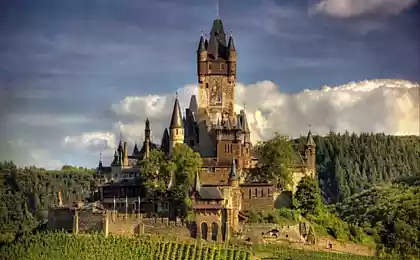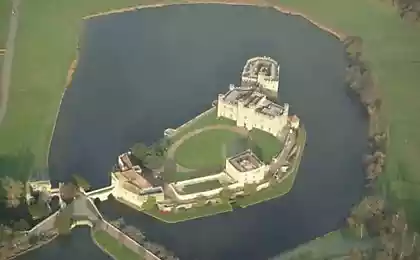658
Palanok Castle
This unique castle is one of the most valuable architectural and historical monuments XIV-XVII centuries. And its beautiful name "Palanok" castle has strengthened around him in a deep water ditch, the palisade-Palanca.
Looking from afar, as a single structure, Palanok actually consists of three different-level parts that are called according to their location, the Upper, Middle and Lower castle. The oldest of them, the Upper castle, originating in XIV-XVI centuries, is located on a mountain top, the Middle castle, built in the XVII century, is situated 6 m below the Top of the castle and, ultimately, Lower castle, Dating from the same XVII century, built on a 10 m below Average. There is another ledge, 10 meters below the third castle, which in the beginning of XVIII century was built a guard tower and the road along the Western slope of the mountain leading to the castle. The tower was destroyed in the early twentieth century, but the road is preserved to this day.


However, the history of the castle begins not in the XIV century and, although the exact date of the castle on this hill almost impossible to define, however the archaeologists have reason to believe that some sort of fortification on this place was in the NINTH century, when the lands of Transcarpathia belonged to the territory of Kievan Rus and, therefore, Mukachevo castle originally belonged to Rus. The cause of the lock, of course, was favorable and strategic location, evidenced by the fact that, despite frequent raids by nomadic tribes, Mukachevo castle never was captured. This lasted until the ELEVENTH century, while the army of the Hungarian Kingdom captured all the Carpathian region and the castle itself. From this period was discovered the first written evidence of Mukachevo castle as the citadel, the only one of all of Transcarpathia, which was in 1086 five-day siege and conquer the Polovtsian troops under the leadership of Khan Koteska. During the Mongol invasion, Mukachevo castle, too, remained intact, the troops of Batu Khan did not even attempt to conquer. And after the withdrawal of the Horde from Transcarpathia castle fortress considerably strengthened to withstand further incursions of enemies.

During XIII-XIV century in the future Palanok belonged to the Hungarian Royal families, Academics and Anjou and had served as guard of the military-strategic paths with a permanent garrison in their territory. At the end of the FOURTEENTH century, in 1396, Mukachevo castle acquired a new owner – a relative of the Hungarian king Zsigmond, Podolsky Prince Fyodor Koriatovych.
The new owner came to strengthen the castle: erected new walls around the castle had dug a deep dry moat, built more towers, three of which have survived to the present day, and added living spaces that were joined together with sophisticated transitions, one of which was nicknamed the "corridor of death". This title shall he made in the ceiling long enough to pass the many small holes, which in the case of penetration of the enemy, poured molten lead. This corridor can be viewed today. In addition, the walls and towers of the castle were installed 164 guns, and around the foot of the mountain was dug additional water ditch with oak palisade, through which the castle got its name.

After the death in 1414 of Fedor Koryatovicha Mukachevo for 4 years until her death passed to his widow Princess Olga. Then for a long time, Mukachevo castle was transferred by representatives of the Hungarian crown by inheritance from generation to generation. After complete destruction by the Turks in 1526 the Hungarian troops and the entire Kingdom, Palanok was a constant struggle between Austria and Transylvania, with the result that the owners followed one after the other. And although in the middle of the XVI century the Hungarians after the defeat of the Austrian troops, under the regained Khust, Mukachevo castle, in 1595, Palanok again became the property of Transylvania. The new owner of the castle Zsigmond rákóczi, and later his descendants until the seventeenth century, castle hill, and the Palanok began actively updated and developed. Was built Middle and Lower castles.
One of the brightest pages of the history of Mukachevo castle is required of the mother of Ferenc Rakoczi II – Ilona Zrini. After the death of her husband of Ilona Zrini re-married a famous Hungarian politician Imre Tekeli. Due to the fact that the new husband was in Alliance with Turkey, the Austrian troops in 1685 began a siege of the fortress of Mukachevo. That is Ilona Zrini for 27 months led the heroic defense of Palanka, which until the beginning of 1688 was the only item which with all its military might could not conquer the Austrian army. Then the Austrians tricked Ilona Zrini to sign in January 1688 the act of surrender. Taking possession of the castle, the Austrians reconstructed the castle according to the rules of fortification demands of that time were destroyed some towers, the system of defence was moved to the foot of the Castle hill.

However, all the reconstruction work did not save Palanok from a new succession of changes of owners: first the Hungarians and then the Austrians. In 1705 Mukachevo castle became a working capital of Transylvania. Most of the time. Already in 1711 Palanok re-turned to the Austrians for two whole centuries. The new owners at the end of the XVIII century turned Palanok first politically, and later a civil prison until 1896 During this time the castle was a great fire that destroyed all wooden buildings, and the maintenance of Palanka in proper form was not interesting. In the period from 1919 to 1938, when Transcarpathia was the territory of Czechoslovakia, Mukachevo castle served as a military base, and during the Second world war, which has already become Hungarian, Palanok was occupied by Hungarian troops. And after the war and the joining of Transcarpathia to the Soviet Ukraine, Mukachevo castle, like many others, have not found a better application how to become a space for vocational schools.


1989 Upper castle Palanka became the Mukachevo historical Museum. At first the Museum was housed in a few dilapidated rooms of the Upper castle, and now there are more than ten expositions, located on an area of 4000 sq. m. Also 12 rooms Palanka set aside for an art gallery, which presents the best works by local artists. Among the paintings there are ancient icons, Dating from the XVI-XIX centuries. And in Mukachevo castle you can see a collection of Easter eggs, an exhibition of paintings displaying all the wooden churches of the Carpathians, to visit several memorial room and art salon, which is where the memory you can buy paintings of local artists as a souvenir or a decorative art.
Few sights in Ukraine can boast such a long and interesting history. Now Palanok is not indifferent to more than 100 thousand tourists a year. Try to visit it and you. The impression of touching the past, combined with beautiful nature are guaranteed. Especially to find Palanok quite easily, from the centre of Mukachevo and the castle walks taxi.
Source: /users/104
Looking from afar, as a single structure, Palanok actually consists of three different-level parts that are called according to their location, the Upper, Middle and Lower castle. The oldest of them, the Upper castle, originating in XIV-XVI centuries, is located on a mountain top, the Middle castle, built in the XVII century, is situated 6 m below the Top of the castle and, ultimately, Lower castle, Dating from the same XVII century, built on a 10 m below Average. There is another ledge, 10 meters below the third castle, which in the beginning of XVIII century was built a guard tower and the road along the Western slope of the mountain leading to the castle. The tower was destroyed in the early twentieth century, but the road is preserved to this day.


However, the history of the castle begins not in the XIV century and, although the exact date of the castle on this hill almost impossible to define, however the archaeologists have reason to believe that some sort of fortification on this place was in the NINTH century, when the lands of Transcarpathia belonged to the territory of Kievan Rus and, therefore, Mukachevo castle originally belonged to Rus. The cause of the lock, of course, was favorable and strategic location, evidenced by the fact that, despite frequent raids by nomadic tribes, Mukachevo castle never was captured. This lasted until the ELEVENTH century, while the army of the Hungarian Kingdom captured all the Carpathian region and the castle itself. From this period was discovered the first written evidence of Mukachevo castle as the citadel, the only one of all of Transcarpathia, which was in 1086 five-day siege and conquer the Polovtsian troops under the leadership of Khan Koteska. During the Mongol invasion, Mukachevo castle, too, remained intact, the troops of Batu Khan did not even attempt to conquer. And after the withdrawal of the Horde from Transcarpathia castle fortress considerably strengthened to withstand further incursions of enemies.

During XIII-XIV century in the future Palanok belonged to the Hungarian Royal families, Academics and Anjou and had served as guard of the military-strategic paths with a permanent garrison in their territory. At the end of the FOURTEENTH century, in 1396, Mukachevo castle acquired a new owner – a relative of the Hungarian king Zsigmond, Podolsky Prince Fyodor Koriatovych.
The new owner came to strengthen the castle: erected new walls around the castle had dug a deep dry moat, built more towers, three of which have survived to the present day, and added living spaces that were joined together with sophisticated transitions, one of which was nicknamed the "corridor of death". This title shall he made in the ceiling long enough to pass the many small holes, which in the case of penetration of the enemy, poured molten lead. This corridor can be viewed today. In addition, the walls and towers of the castle were installed 164 guns, and around the foot of the mountain was dug additional water ditch with oak palisade, through which the castle got its name.

After the death in 1414 of Fedor Koryatovicha Mukachevo for 4 years until her death passed to his widow Princess Olga. Then for a long time, Mukachevo castle was transferred by representatives of the Hungarian crown by inheritance from generation to generation. After complete destruction by the Turks in 1526 the Hungarian troops and the entire Kingdom, Palanok was a constant struggle between Austria and Transylvania, with the result that the owners followed one after the other. And although in the middle of the XVI century the Hungarians after the defeat of the Austrian troops, under the regained Khust, Mukachevo castle, in 1595, Palanok again became the property of Transylvania. The new owner of the castle Zsigmond rákóczi, and later his descendants until the seventeenth century, castle hill, and the Palanok began actively updated and developed. Was built Middle and Lower castles.
One of the brightest pages of the history of Mukachevo castle is required of the mother of Ferenc Rakoczi II – Ilona Zrini. After the death of her husband of Ilona Zrini re-married a famous Hungarian politician Imre Tekeli. Due to the fact that the new husband was in Alliance with Turkey, the Austrian troops in 1685 began a siege of the fortress of Mukachevo. That is Ilona Zrini for 27 months led the heroic defense of Palanka, which until the beginning of 1688 was the only item which with all its military might could not conquer the Austrian army. Then the Austrians tricked Ilona Zrini to sign in January 1688 the act of surrender. Taking possession of the castle, the Austrians reconstructed the castle according to the rules of fortification demands of that time were destroyed some towers, the system of defence was moved to the foot of the Castle hill.

However, all the reconstruction work did not save Palanok from a new succession of changes of owners: first the Hungarians and then the Austrians. In 1705 Mukachevo castle became a working capital of Transylvania. Most of the time. Already in 1711 Palanok re-turned to the Austrians for two whole centuries. The new owners at the end of the XVIII century turned Palanok first politically, and later a civil prison until 1896 During this time the castle was a great fire that destroyed all wooden buildings, and the maintenance of Palanka in proper form was not interesting. In the period from 1919 to 1938, when Transcarpathia was the territory of Czechoslovakia, Mukachevo castle served as a military base, and during the Second world war, which has already become Hungarian, Palanok was occupied by Hungarian troops. And after the war and the joining of Transcarpathia to the Soviet Ukraine, Mukachevo castle, like many others, have not found a better application how to become a space for vocational schools.


1989 Upper castle Palanka became the Mukachevo historical Museum. At first the Museum was housed in a few dilapidated rooms of the Upper castle, and now there are more than ten expositions, located on an area of 4000 sq. m. Also 12 rooms Palanka set aside for an art gallery, which presents the best works by local artists. Among the paintings there are ancient icons, Dating from the XVI-XIX centuries. And in Mukachevo castle you can see a collection of Easter eggs, an exhibition of paintings displaying all the wooden churches of the Carpathians, to visit several memorial room and art salon, which is where the memory you can buy paintings of local artists as a souvenir or a decorative art.
Few sights in Ukraine can boast such a long and interesting history. Now Palanok is not indifferent to more than 100 thousand tourists a year. Try to visit it and you. The impression of touching the past, combined with beautiful nature are guaranteed. Especially to find Palanok quite easily, from the centre of Mukachevo and the castle walks taxi.
Source: /users/104























